Film of the Week: Rojo
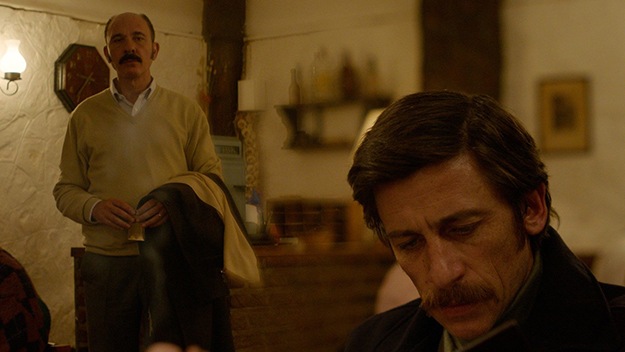
Images from Rojo (Benjamín Naishtat, 2018)
Benjamín Naishtat’s Rojo is a mystery thriller of sorts. That is, it comes across like a thriller, but remains fundamentally mysterious throughout, weaving a texture of loose ends and tantalizing enigmas. One thing that seems to set us on a clear footing at the start is the introductory caption, “In an Argentinian province—1975”—in other words, a year before the coup that established Argentina’s seven-year military dictatorship, in which some 30,000 were “disappeared,” to use the familiar euphemistic term, by government forces.
Knowing where you are with Rojo, or thinking you know where you are, can lead you up the wrong path, as in an early scene that I suddenly realized I had fundamentally misinterpreted—which may be just me, or the film’s design. In a restaurant, amid a chatty, buoyant crowd, a middle-aged man, Claudio (Darío Grandinetti, from Wild Tales and Almodóvar’s Talk To Her and Julieta) sits alone quietly perusing the menu. Another man walks in scowling, in polo neck, black blouson and a very ’70s mustache, and starts throwing his weight around, berating Claudio for taking up space at a table when he, the newcomer, could be sitting and ordering his meal. The interloper’s look, his menacing tone of someone out for trouble, suggested, given the date of the action, that he was a representative of the brutish new order that would soon rule the country.
Meekly and politely, Claudio gets up to give the man his table—then stands at the back of the room and launches, loud enough for everyone to hear, into a comprehensive demolition of the man’s character, in courteous tones that are nevertheless devastatingly cruel. It’s clear at this point who is really in power—the quiet, privileged bourgeois with the cool grip on his rhetoric. The newcomer freaks out, raging at everyone in the place, calling them all Nazis. No right wing authority figure, then, but something else—and crushed by someone with real social power.
What then happens between the man and Claudio is surprising, shocking, and not easy to explain—and is then left dormant in the film for some time while other plot strands move into the foreground. This thread though, is presented in a slow-burning, self-enclosed episode that carries the film from its start—after an extraordinary wordless opening shot—up till 23 minutes in, at which point the film’s title at last appears in a dramatic stylized font.
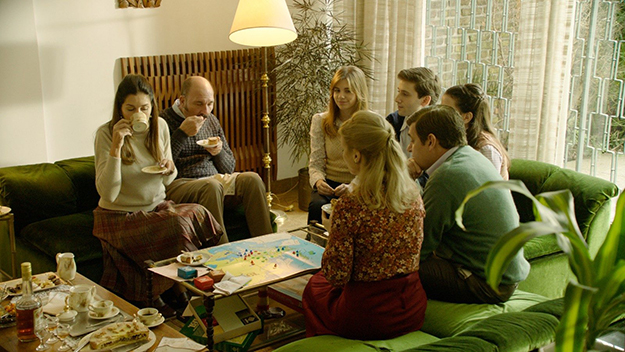
This is just one of several narrative strands interwoven by writer-director Naishtat, and for the most part they are suggestive, ominous rather than directly eventful in themselves, each seeming to work towards some resolution that doesn’t always come when and how we expect it —or indeed at all. Claudio is a provincial attorney who lives in a suburban house, sumptuously furnished in high ’70s style, with his wife Susana (Andrea Frigerio, somewhat under-used) and daughter Paula (Laura Grandinetti, Darío’s real daughter). An upstanding, eminently respectable bourgeois, Claudio is seen riding a little high-handedly over a working-class client who has just lost his job and, in some desperation, is taking action to get severance pay. Claudio’s friend Vivas (Claudio Martínez Bel), a smarmy, conniving businessman, is keen to buy a house recently abandoned in a hurry by its owners. It isn’t officially for sale, and he wants Claudio’s help in acquiring it—which will involve getting in a third party, i.e. a stooge, to pose as the official buyer, keeping his own name clean.
The property in question, it turns out, is the one seen in the extended opening shot—a terrific, coolly paced episode in which a series of individuals emerge from the front door carrying assorted furnishings and household goods. They are neighbors looting a suburban house whose owners seem to have fled overnight, leaving all their possessions behind. This departure is the first of several disappearances in the film—voluntary, in the name of survival, or forced, as Argentina is becoming a very dangerous place, especially for those with left-wing sympathies. Claudio and Vivas visit the house, where all the signs are sinister—a drawer of family pictures abandoned forever, bloody handprints on the walls, a neighbor who takes such disappearance as the new norm.
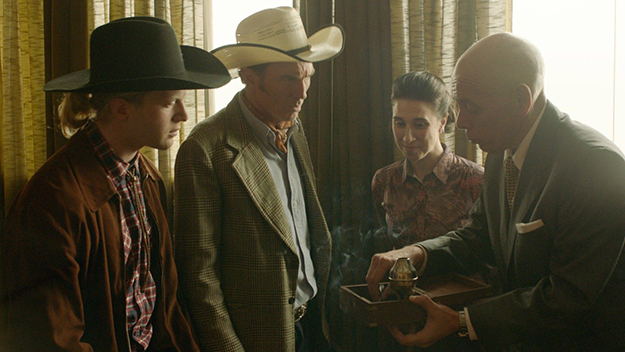
Other strands are harder to interpret, partly because they don’t directly involve Claudio. There’s the ballet that Paula is rehearsing at school, a representation of Argentina’s history, in which colonialists confront indigenous people: “savages” (selvajes), the teacher calls them, before giving Paula a mini-lecture on the meaning of “intention” and how to show it, which apparently means fixing your opponent with a terrifying stare. There’s also a visit to a rodeo and a sub-plot involving a visiting delegation of American cowboys whose arrival has been delayed “thanks to the negligence of the former administration,” according to the authority figure newly installed in the region. He’s there as part of the “federal intervention” by which the province has had its administration changed by the government. The “intervention” is a technicality which may remain obscure to anyone not conversant with this period of Argentine history, although it’s clear that the intervenor’s power isn’t altogether benign: when a journalist dares ask an awkward question, he demands his name and publication, leaving the journalist looking very uneasy. When the cowboys arrive, they are made a big fuss of, and we hear a radio broadcast celebrating their presence: “Watch the grace of the American horse galloping on Argentine soil”—not entirely oblique shorthand for the USA’s part in the coup.
Another sub-plot involves Paula’s boyfriend Santiago (Rafael Federman), who is jealous of her partner in dance class; clean-cut and presentable in sensible shirt collar and pullover, he’s later seen out on the streets with his high school friends, looking for trouble. That this paragon of genteel respectability turns out to be such bad news says much about the society around him; again, this troubling strand doesn’t reach an explicit conclusion, but leaves us wondering exactly what has happened next, and how.
For the most part, decisive events—arrests, assaults, the disposal of bodies—happen offscreen in Rojo. It’s as if the society depicted here were conspiring to see nothing, or as if these things are somehow too terrible—too blinding—to contemplate directly. That interpretation is certainly suggested by another enigmatic episode, which gives the film’s title, which translates as “red,” at least one of its apparent meanings—a trip to the seaside, where an eclipse briefly turns the screen an intense scarlet.
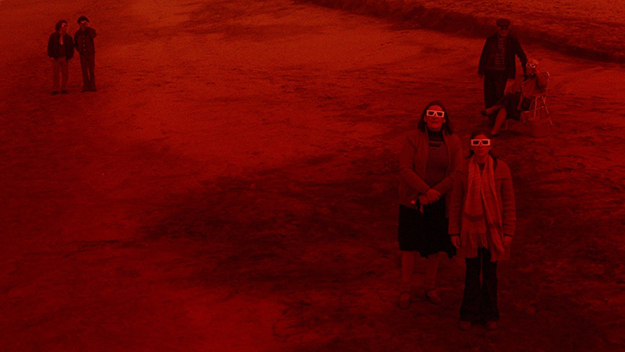
For a long while, Naishtat builds up fragment after fragment, episode after episode, withholding resolution—until a character enters who proposes to answer a few burning questions decisively, and whose presence instantly changes the film’s dynamic. He is Sinclair, a Chilean detective who has become a star in Argentina presenting his own police investigation show on TV—something he never lets anyone forget. He’s played by Alfredo Castro, the lead of Pablo Larraín’s Tony Manero and Post Mortem—films which established him as one of the most unsettling figures in world cinema, a presence as irreducibly singular as Toni Servillo, or Klaus Kinski in his prime.
Castro skates here with precarious daring on the edge of self-parody; yet that’s very much part of Sinclair’s narcissistic make-up, and the actor is mesmerizing in the role. His entrance is extraordinary: it’s fair to say that he simply materializes out of nowhere, a silky, serpentine presence glaring chilly-eyed in the background. There’s a remarkable image of Sinclair pointing an accusing finger like a gun, as if he’s posing for a movie poster; and in contrast, a moment of truth where he stands facing Claudio, the detective little more than chest high but giving the bigger man a blast of that chilling “intention” the dance teacher talked about. Castro is also very funny in a church scene, as Sinclair lashes out testily at a woman in need of help, who happens to have disturbed the Christian lawman’s pious contemplation. Castro’s portrayal of a larger-than-life character prone to hysterical narcissism plays beautifully against the more self-enclosed elegance of Grandinetti’s ambivalent, somewhat feline performance.
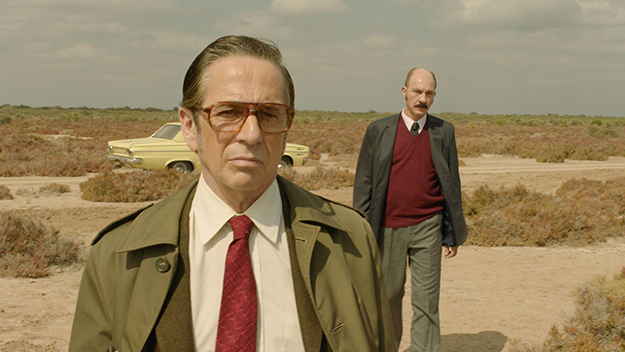
Naishtat’s first feature History of Fear (2014), set in an exclusive housing estate, was an enigmatic, rigorously chilly piece that used atmospherics and eerie ellipsis to evoke an Argentina racked with anxiety (his follow-up, 2015’s The Movement, offered an austere take on 19th-century national history). Rojo is a highly commercial film, relatively speaking: internationally known actors, polished retro stylization, a coolly detached thriller format that recalls vintage Claude Chabrol in its forensic dissection of the moral compromise of a pampered bourgeoisie. Visually, the film plays on ’70s style both in mise en scène and filmic grammar. The color palette—costumes, interiors, cars—plays on the drab hues of the period, all beiges and rusts, like the bland sandy pullover worn by Claudio. But DoP Yarara Rodriguez also pulls off some more expressionistic color effects, like an extraordinary early shot of a yellow car on blue sand, red lights glowing under a desert dawn sky. There are also effects that suggest that we’re watching a ’70s TV drama: zooms, incongruous slow-motion sequences, and an early passage of Vincent van Warmerdam’s score, which sets rasping sax against guitar and vibes chords (later, he brings in a baleful violin, which gets scrapier and more portentous as the film develops).
Rojo isn’t the only recent Argentinian film to use stylistic exaggeration to recreate this fraught decade in the nation’s history: Luis Ortega’s recent El Angel was a true crime story set just a few years earlier, more indirectly gesturing at general social unrest, but too invested in camp and sensationalism to get us asking any wider questions. Rojo, by contrast, uses both familiarity and distanciation to depict a society that never appears that different from the world we know. As a drama about how the privileged middle class only too easily, whether knowingly or blindly, finds itself complicit with state crimes, Rojo is clearly a film both about its moment, and disturbingly timeless. Naishtat succeeds in making us uncomfortable right up to the final freeze frame of Claudio looking straight ahead—and there’s nothing like a closing freeze frame to throw a film right into its viewer’s lap.
Jonathan Romney is a contributing editor to Film Comment and writes its Film of the Week column. He is a member of the London Film Critics Circle.







